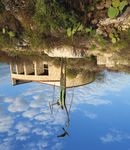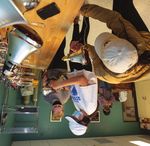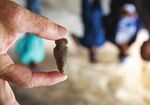Rock Stars High school students pair with archaeologists in nature's classroom - LINE GEAR EVOLUTION
←
→
Page content transcription
If your browser does not render page correctly, please read the page content below
LEARN ABOUT SEE CHET LOOK AT OUR
LINE GEAR EVOLUTION VISIT ROUND TOP POLITICS TIMELINE
F O R E L E C T R I C C O O P E R AT I V E M E M B E R S OCTOBER 2021
Rock
Stars
High school students
pair with archaeologists
in nature’s classroomLEARNING
ROCKS
Comstock high school coursework
includes rock art research with
Shumla archaeologists
B Y PA M L E B L A N C • P H O T O S B Y E R I C H S C H L E G E L
The Maker of Peace sculpture stands
outside the Seminole Canyon State
Park and Historic Site visitors center.
8 T E X AS CO - OP POW E R OCTOBER 2 021 T E X ASC O O P POWER .C OMLEF TComstock student Sammy Isaac reaches into
a hole where grains or paint dust were stored some
2,000 years ago inside the Fate Bell Shelter. ABOVE
Students found a projectile point while working with
Shumla archaeologists at Seminole Canyon.
that line this canyon in the Lower Pecos Canyonlands. “This
is one of the best places to study hunter-gatherers. We can
see more than stone tools. We can see how they lived.”
The rock shelters—more than 300 have been identified
in Val Verde County—also serve as valuable classrooms for
students in their final year of high school in Comstock, a
tiny, one-school town of fewer than 400 people about 30
miles northwest of Del Rio. Every senior in the Comstock
Independent School District—there are seven for the 2020–
2021 school year—works alongside archaeologists and
chemists as they study the region’s renowned rock art.
In the past few years, students from the school have
helped build a plasma oxidation instrument that scientists
will use to extract organic material from paint flakes so they
can date the rock art. Previous classes have labeled rock art
murals, measured painted images, entered data into com-
puters and learned how to use imaging software. In short,
the program, introduced in 2013 and structured as an inter-
O N A B R E E Z Y A P R I L M O R N I N G , five Comstock high school disciplinary internship, allows the students from a small
seniors clamber around boulders and hop across a stream high school in South Texas to learn sophisticated archaeo-
in Seminole Canyon on their way to inspect some of the logical analysis and physical sciences from the pros.
finest examples of rock art in the world. The class not only helps Shumla, a nonprofit organiza-
After a 20-minute hike, they reach the foot of Fate Bell tion founded more than 20 years ago to study and docu-
Shelter, a curved hollow midway up the cliff wall that’s big ment rock art in the region, but also gives the students
enough for a game of baseball. The students, along with hands-on experience in a working laboratory.
science teacher Kayme Tims and chemist Karen Steelman, Because of the COVID-19 pandemic, class looks a little
scramble up to the rocky amphitheater, where they can see different this year. Steelman and Tims meet with the stu-
faded red, yellow and black images painted there more dents two or three times a week via Zoom. Besides studying
than 2,000 years ago. various styles of rock art and learning how ancient people
“This place is so special, and it’s not just because of the used animal fat and crushed minerals to make paint, the
rock art,” says Steelman, science director of the plasma students study plants that were used for food, clothing and
oxidation lab at Shumla Archaeological Research and Educa- shelter. They learned, for example, that cochineal, a type of
tion Center in Comstock, explaining that ancient fiber mats, scale insect that lives on prickly pear cactus, was used to
sandals and rabbit furs have been found in the rock shelters make red and orange dyes.
TE X ASC OO PPOW ER .CO M O CTO BER 2 021 T EX AS C O- OP POW ER 9Science teacher Kayme
Tims leaps across a stream
in Seminole Canyon.
“I have two goals: first, teach
some chemistry using the archaeol-
ogy of the Lower Pecos as a frame-
work. Second, teach students an
appreciation for the amazing cul-
tural archaeology that’s right in our
backyard,” Steelman says.
That plan is working. At Fate Bell
Shelter, the students use a smart-
phone app called DStretch to photo-
graph the artwork and then enhance
its color so the images are more
clearly visible.
“I think it’s pretty cool that it’s
right here in our backyard,” says
Sammy Isaac, 18, of Comstock as
the images jump into focus.
“Can you imagine painting some-
thing and it lasting that long?”
Steelman says as the students point
out features of the Lower Pecos
River style artwork—anthropomor-
phic figures with outstretched arms,
holding bundles of what look like
darts. “These were master artists;
they were good.”
S C I E N T I S T S AT S H U M L A
recently
helped secure National Historic
Landmark status for the rock art in
the Lower Pecos Canyonlands, one
of the most important archaeologi-
cal regions in the world, according
to eminent French prehistorian
Jean Clottes. And last year they completed comprehensive skyward. Experts don’t know for sure, but some believe
documentation of 233 rock art sites for the Alexandria Proj- paintings like this represent spiritual or religious beliefs.
ect, their effort to preserve these oldest “books” of painted “The rock art tells stories about family, religion and past
texts in North America. events,” says Courtney White, 18, of Del Rio. “When I found
Together Steelman and Tims have taught successive out about it, I learned more respect for the people who
groups of Comstock seniors about concepts from pigment made it. What they painted was heartfelt. What was impor-
analysis to radiocarbon dating. The educators say they tant to them should be important to me.”
hope the basic chemistry knowledge will give students an After 45 minutes of exploring the Fate Bell Shelter, the
edge in college and an appreciation of the cultural impor- group climbs down and hikes another mile along the rugged
tance of where they live. creek bed, scrambling through underbrush, hopping over
“I hope they realize what we have here, that it’s unique; streams and climbing up smooth rock to another shelter,
they grew up somewhere with significance,” Tims says. known to scientists as 41VV75. This site, Steelman tells the
Back in the Fate Bell Shelter, the students gather in front students, has been used for more than 8,000 years, although
of the faint outline of a figure, one hand holding what looks the images painted on its walls are half that age, according to
like a bundle of sticks. They note that some of the figures’ radiocarbon testing. The students explore the site, noticing
hair looks like it’s standing on end—a characteristic known fibers from ancient mats made of plants. A few look down the
as piloerection that has various interpretations. canyon, talking about what it must have been like to live here.
At one point, the five students line up in front of one Only a fraction of the rock art in the Lower Pecos
section of the mural, laughing a little as they re-create a scene Canyonlands has been radiocarbon-dated. “That’s one
on the wall depicting five figures, one with its arms reaching thing students are helping me with—developing a labora-
1 0 T E X AS CO - O P POW E R OCTOBER 202 1 T E X ASC O O P POWER .C OM‘The rock art tells
stories about family,
religion and past
events. When I found
out about it, I learned
more respect for the
people who made it.
What they painted
was heartfelt. What tory at Shumla so we can do more research and study the
ages of different styles of art and how [the style] may have
was important to
changed through time,” Steelman says.
them should be
After breaking for lunch next to huge boulders in the
important to me.’
canyon, the students load up and head back to Shumla
headquarters, housed in what was once a U.S. Border Patrol
building in Comstock. There, they file into the lab to check
out a plasma oxidation instrument built by the previous
year’s students. The instrument spans nearly an entire wall,
its row of orangey-red lights reminiscent of the heating
lamps used to keep fried chicken or pies warm at a fast-
food restaurant.
But this $83,000 piece of equipment, funded through a
grant from the National Science Foundation, won’t be used
to warm lunch; Steelman and Lori Barkwill-Love, a college
intern, will use it to extract organic material from dime-
sized flakes of paint carefully obtained from rock art
murals. That material will be sent to another lab for radio-
carbon dating.
“The instrument is custom-built with all these parts,
basically like Lego blocks,” Steelman says. “It was the per-
fect opportunity for students to come into the lab and help.”
This year’s class will build on the work of last year’s
seniors. Before the school year ends, they will assemble a
new electrode array for the plasma oxidation instrument in
TOP A student uses the DStretch app to this world-class lab. The project requires scientific design
photograph and enhance rock art. AB OVE as well as practical skills such as drilling through PVC pipe,
Students in the Shumla research lab. threading copper wire through the piping and measuring
twice, so you only have to cut once.
And those are lessons that most students never get in
W E B E X T R A Find more photos
with this story online and learn more high school. D
about cochineal in The Bugs That
Make You See Red [February 2019].
TE X ASC OO PPOW ER .CO M O CTO B ER 2 021 T E X AS CO -O P POW ER 11You can also read

























































